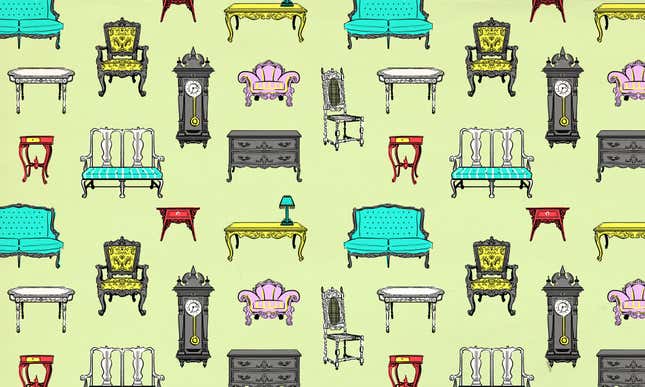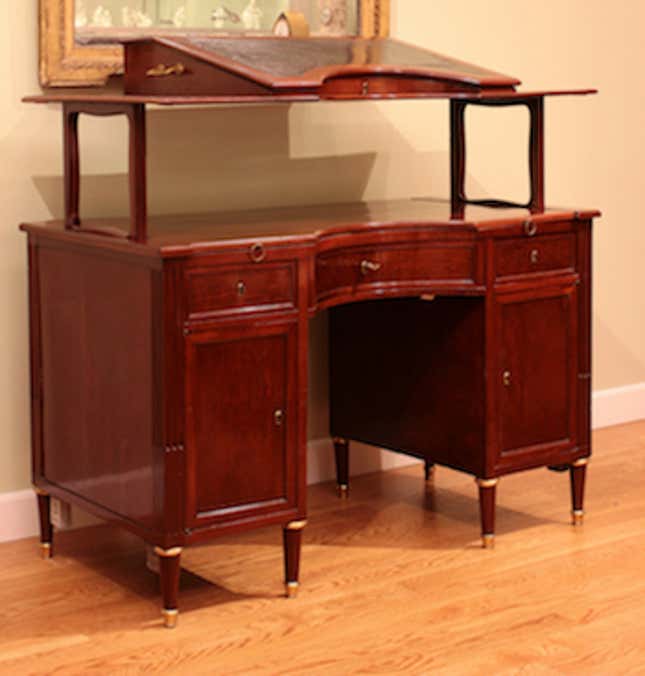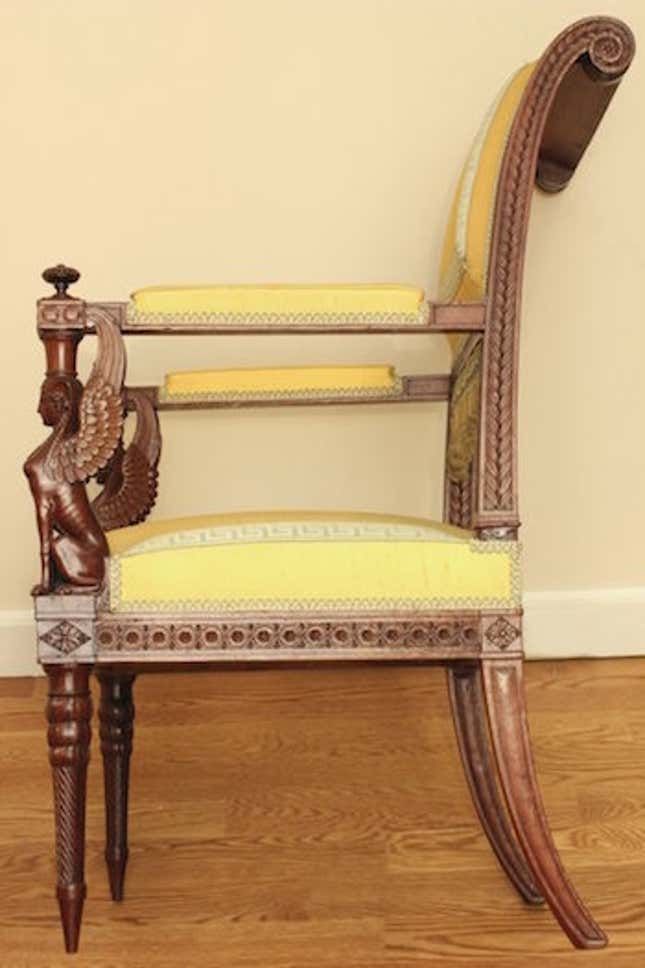
That’s right: antiques. Now, let me guess your Pavlovian response: drab chairs you wouldn’t trash-pick even without the bed-bug anxiety, grandmotherly floral couches in their eternal plastic seals, mildew mingling with stale perfume, and no delicious Swedish meatballs in sight. But you’ve got it all wrong. I’m a dealer of 18th-century French furniture at a family business that’s lasted three generations; this is what you need to know.
Antiques are handmade, unique, durable, interactive objects of art. Unlike shiny Jeff Koons dogs, you’ll actually use them, and you don’t need to secretly mortgage all of your relatives’ homes to buy one. And unlike those handsome wingtips of yours, antiques appreciate in value over time and never smell sock-y after a good rain.
A single antique casts a reflected glow over everything else in a room. Snag yourself a large antique armchair, then watch: Your West Elm coffee table with the similar wood finish suddenly acquires life, and that poster you’ve been meaning to frame since sophomore year looks radder. That chair will be a great conversation piece for dates who talk about The Goldfinch while they rush to sit on it.
Owning an antique is an uniquely personal experience. An object in a museum, no matter how great, is a caged animal—suffocating, alone, diminished behind glass. But when a piece is yours, when you can touch it and live with it, you’re forging a relationship with history. When that date asks for the story behind one of your chairs instead of marveling at the difficulty of its glyphic assembly instructions, your apartment is suddenly individualized.

Antiques are flexible. The 18th-century French period is wonderful. These are curvaceous pieces from a time when patrons who make our modern-day 1 percent look plebian were commissioning the world’s best artists to make unique decorative objects. The styles are directly related to the aesthetic of individual royals—Louis XVI furniture has straight legs, Marie Antoinette’s plates have roses—but if it’s not your taste, you could look at Empire if you love the bold lines of Art Deco, or try Asian porcelain for a splash of color, or go for American Folk if you want your space to feel handmade. When you shop for antiques, you’ll exponentially increase the options within your personal aesthetic and get beyond the drab cookie-cutter vibe of contemporary furniture.
They’re great investments. This is where I’m tempted to tell you that this is the best time to buy in decades—and that antiques are inflation-proof, track upward with the art market, and sometimes catch fire almost inexplicably (people are literally making 10,000-percent profits on their Chinese vases right now)—but this website ain’t called Crass Man, so let’s exeunt.
How To Hunt
The most important trick is the simplest: Look for quality. This is what’s so awesome about antiques—it’s not like now, when the best artists are all independently making fine art. In 18th-century France, expertise was so important that you needed to submit a masterpiece before even being allowed to make furniture. At my shop, we’ll buy something from that period simply because it’s interesting and well-made, knowing that there must be a story lurking. That’s when research can kick in—we once bought a sled because it had great ironwork, so it wasn’t a huge surprise (though it was a happy one) when it turned out to have belonged to Louis XIV.

Make sure to check for woodworm damage—which you want! This will look like little holes pockmarking the wood. The older a piece, the more holes you hope to see. A good forger knows this, so shine a little flashlight into a random hole—if it was made by a crafty drill, the track will be straight, not a meandering beetle’s path. Next, go underneath the object where the wood is unfinished (if it is finished, run). You don’t want anything that looks too pristine or new. This doesn’t apply to mahogany—too hard to be delicious, and subtle in its aging—but mahogany is still illustrative. It took months to get it back then; you needed boats upon boats upon boats relaying from Brazil to France. People died for mahogany. Owners were justifiably proud of their materials, so look for objects that feature the wood’s imperfections instead of covering them up.
If a piece has bronze mounts, unscrew one. On an older bronze, there should be two colors on the back: a tiny rim of gilding from the front and a dark oxidized center. This is a great hint that it’s old, not a reproduction—those later bronzes will have completely gilded backs.
Look for work that seems unusual. Consider a piece recently catalogued as a simple desk by an auction house that’ll remained unnamed. At the pre-sale exhibition, I noticed that small counterweights were dangling under the frame. That meant something. We never fiddled with it there—didn’t want to give the game away—but after purchase, it turned out to be a more interesting—and more valuable—pop-up architectural desk. This was a Da Vinci Code moment without the hassle of self-flagellating albinos.
When it comes to iconography, most everything is there for a reason. If you see a pheasant on top of a mirror, don’t just be like, “Oh, neat bird.” Pull out your phone and search mirrors and pheasants—hmm, not too many. And the mirror is Italian, but, holy shit, there’s a crazy-tiny island called the Isle of Pheasants that’s owned by France six months of the year and Spain six months of the year, and there was a royal wedding between Italy and Spain around the time the mirror was made …
Where To Look
You can do really well for yourself at auctions. Most auction houses don’t have time to individually research each piece, so you can sometimes find steals. Pre-sale exhibitions are open to the public: Grab a catalog and compare, with an eye for things that are dirty or poorly lit or different from the pictures. You’re trying to get an edge on online shoppers and people just glazing through, so don’t forget: You can touch these things. Go wild. Crawl underneath. Flip a piece over. Lift a marble top off a console (these are almost never attached to the piece—they sit heavily on the frame) to check the construction quality underneath. Sotheby’s and Christie’s are the gold standard, but you have less chance of finding hidden treasures there than with the smaller, local houses.
Bidding is a dangerously addictive game of brinksmanship. If the auctioneer is the only one talking back at you, it probably means he has a bid made in advance by an absentee buyer. Respond quickly each time and you might be able to snag it before anyone else gets in. If you’re coveting a piece that someone else in the room is after (especially if it’s a phone bidder), wait until they’ve almost taken it down, then strike. This is that rare thing that works exactly like in the movies. You want to break the auctioneer’s rhythm after going once, startling the bidder who has already started to psychologically believe that the sweet couch is theirs. Remember, though: At an auction, you’re paying an extra percentage on top of your bid.

Go to a shop. Auctions are great, but they’re a crapshoot. Antique dealers will have pre-vetted objects, so even if you’re not going to buy, make a visit and ask lots of questions. I like to act a bit insouciant at first, so that when I haggle, the dealer will hopefully be pleasantly surprised. Yes, haggle. Always. I semi-guarantee that you can get at least 20 percent off from list price—this is the discount most stores extend to interior decorators, so they’re already mentally prepared. Don’t be scared or shy. Do it with a smile, like you’re having fun. Because it is fun! I love it when customers haggle. Just make sure not to knock the object—praise it, love it, and you’ll be in sync with the dealer’s eye. They want to sell the piece to someone who shares their aesthetic.
There’s tons of interesting stuff online, but start out in person if you can. If you’re not living near a shop or an auction house, set some Google alerts and follow the market. Collecting is like learning a language: Immersion and time are the best teachers
You’re ready. And now, the best part awaits—even more then the thrill of the chase. Because when you take these pieces apart (another perk of collecting), you’ll find insane levels of care all the way down. Every drawer, every hinge will be numbered. Every hand-made nut attaches to its very own hand-made bolt. Everything matters. Personality and skill everywhere. So much of the stuff made today trends towards normalization; I know it sounds like a paradox, but antiques will make your space feel new.
Adam Dalva is a writer and dealer of French antiques in New York. He tweets at @adalva, his writing can be found at adamdalva.com, and his antiques can be found at dalvabrothers.com.
Lead illustration by Tara Jacoby. Antique photos provided by the author.
Adequate Man is Deadspin’s self-improvement blog, dedicated to making you just good enough at everything. Suggestions for future topics are welcome below.